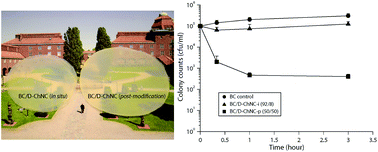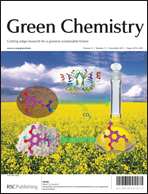Nanocomposites of bacterial cellulose nanofibers and chitin nanocrystals: fabrication, characterization and bactericidal activity
Abstract
An environmentally friendly approach was implemented for the production of nanocomposites with bactericidal activity, using bacterial cellulose (BC) nanofibers and chitin nanocrystals (ChNCs). The antibacterial activity of ChNCs prepared by acid hydrolysis, TEMPO-mediated oxidation or partial deacetylation of α-chitin powder was assessed and the structure of the ChNC nanoparticles was characterized by X-ray diffraction, atomic force microscopy, and solid-state 13C-NMR. The partially deacetylated ChNCs (D-ChNC) showed the strongest antibacterial activity, with 99 ± 1% inhibition of bacterial growth compared to control samples. Nanocomposites were prepared from BC nanofibers and D-ChNC by (i) in situ biosynthesis with the addition of D-ChNC nanoparticles in the culture medium of Acetobacter aceti, and (ii) post-modification by mixing D-ChNC with disintegrated BC in an aqueous suspension. The structure and mechanical properties of the BC/D-ChNC nanocomposites were characterized by Fourier transform infrared spectroscopy, elemental analysis, field-emission scanning electron microscopy, and an Instron universal testing machine. The bactericidal activity of the nanocomposites increased with the D-ChNC content, with a reduction in bacterial growth by 3.0 log units when the D-ChNC content was 50%. D-ChNC nanoparticles have great potential as substitutes for unfriendly antimicrobial compounds such as heavy metal nanoparticles and synthetic polymers to introduce antibacterial properties to cellulosic materials.


 Please wait while we load your content...
Please wait while we load your content...